

EAP Publications | Virtual Library | Magazine Rack | Search
Join the Ecological Solutions RoundtableEAP Publication - 59
Doryphore de la Pomme de terre
Leptinotarsa decemlineata
DESCRIPTION and LIFE HISTORY
* indicates damaging stage
*Adult (1 cm):
Stout, oval; 10 yellow and 10 black stripes down back, which is very convex.
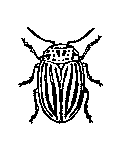
Yellow; laid on end in clusters (12 or more) on underside of leaves, over 4-5 week period; hatch in
4-9 days
Hump-backed, red grub with 2 rows of black spots per side black head; matures in 2-3 weeks
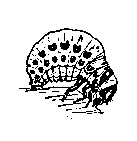
Yellowish, in soil; adult emerges in 5-10 days.
1-4; one in eastern Canada; overwinters as adult 20-25 cm underground.
DAMAGE
Attacks POTATO, TOMATO, EGGPLANT, PEPPER and various WEEDS.
Rapidly defoliates plant spreads diseases (e.g., spindle tuber, bacterial wilt~ ring rot.)
Leaves messy black deposit on leaves as it feeds.
Altise de la pomme de terre
Epitrix cucumeris
* indicates damaging stage
Black or brown, jumping beetle; feeds on weeds and tree foliage until vegetable shoots appear; may feed for over 2 mos; hibernates in soil, under crop remnants, etc.
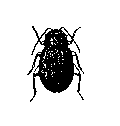
Tiny, not readily seen; laid in June in or on soil near base of plant; hatch in 7-10 days.
Slender, white; brownish head feeds on plant roots or tubers for 2-4 weeks.
In soil for 7-10 days
1-4: 1 or 2 in eastern Canada
Attacks POTATO, EGGPLANT, TOMATO, EGGPLANT, etc .
Adults eat tiny shot-like holes in leaves (mostly from beneath).
Larvae attack underground parts and transmit plant diseases, e.g., spindle tuber. blight, brown rot, scab and scurf.
1 Sold as Puroguard® and Fossil Flower®. "INSECTIGONE"
2 Use Tangletrap®
3 Includes BROCCOLI, BRUSSEL SPROUT, CABBAGE, CAULIFLOWER, KALE, KOHLRABI, MUSTARD, RADISH, RUTABAGA, TURNIP, etc. and related weeds.
Ver-fil-de-fer / Taupin
* indicates damaging stage
Elongate brown or black "click' beetle"; flips in air when placed on its back; sides taper toward rear; lives 10-12 months; lives mostly on or underground, but can fly. Do not confuse with beneficial GROUND BEETLES.
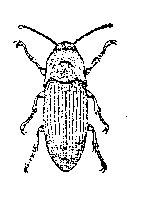
Laid singly in damp soil in May and June; hatch in a few days to weeks.
Shiny, slender, hard, jointed. yellowish to brown; found year-round in most soils; lives 2-5 years, moving only a few yards in this time; may bite if held in the hand
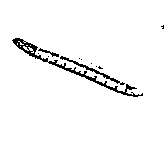
In soil in late summer; adult emerges the same fall.
Overlap; find larvae of many ages at any given time; overwinters as larva and adult, in soil. DAMAGE
Very destructive and hard to control; attacks CORN, POTATO, BEET, BEAN, LETTUCE, CABBAGE, CARROT, ONION, PEA, TURNIP. SMALL GRAINS~ GRASSES
Eats underground parts of stems, roots and seed. Crop may fail to germinate, or comes up in patches, then die, or wither later in the season.
Perce-oreille européen
Dermaptera
* indicates damaging stage
Dark brown, slender, elongate; pair of "pincers" at rear; runs more than flies; curves up abdomen and releases foul odour when disturbed; resembles the beneficial ROVE BEETLE, which has no pincers.
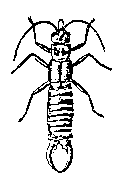
White, approximately 30 laid in underground nest in winter and brooded by female (in south, also laid in summer); hatch in April.
Guarded by female when young; develops gradually into adult by July.
1-2; overwinters as adult or egg.
Generally beneficial: eats decaying matter, insect larvae snails. etc.
Occasional infestations may attack flowers (DAHLIAS, CARNATIONS, CHRYSANTHEMUMS MARIGOLDS), food plants (LETTUCE, CELERY, POTATO, BEETS, BEANS, STRAWBERRY).
Young nymphs eat seedlings & chew holes in leaves of many kinds of vegetables and flowers; adults eat stamens, petal bases of flowers, and ripening fruit of orchard trees.
Mouche du chou
Hylemya brassica
* indicates damaging stage
Like small housefly; starts to emerge in April.
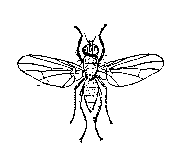
Small, white; laid in soil or at base of plant; hatches in 3-7 days.
Legless, white maggot; blunt rear, pointed front; pupates after 3-4 weeks.

In soil, 3-15 cm deep; adult emerges in 2-3 weeks or overwinters.
Attacks CABBAGE family1 CELERY. BEET.
Tunnels through or feeds on surface of roots, leaving brownish grooves. Plants are stunted, lower leaves discoloured, wilt more than normal in sun and often die. May introduce diseases (e.g. bacterial soft rot, fungal blackleg.)
The similar ONION MAGG0T attacks ONIONS only.
1 Includes BROCCOLI. BRUSSEL SPROUT. CABBAGE. CAULIFLOWER. KALE. KOHLRABI. MUSTARD. RADISH, RUTABAGA, TURNIP, etc. and related WEEDS.
2 Sold as Purocuard® and Fossil Flower®.
Piéride du chou
Pieris rapae
* indicates damaging stage
White butterfly; 3-4 black spots on each wing.
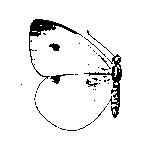
Tiny, yellow, bullet-shaped; laid singly on leaf underside; hatch in 7 or more days.
Velvety green caterpillar with orange back-stripe, broken yellow side-stripe; feeds for about 15 days, then pupates.

In cocoon held by thread against a leaf, stem, or other object. Adult emerges in about 10 days.

2-3 in northern range, mor~ in south. Overwinters as pupa in crop debris.
Attacks CABBAGE family**. LETTUCE , NASTURTIUMS.
Eats large irregular holes in leaves, crawls or bores into CABBAGE head. Contaminates plants with its waste (greenish to brown pellets).
** Includes BROCCOLI, BRUSSELS SPROUT, CABBAGE, CAULIFLOWER, KALE, KOHLRABI, MUSTARD, RADISH, RUTABAGA, TURNIP, etc. and related WEEDS.
1 Sold as Dipel® and Thuricide®
2 Sold as Puroguard® and Fossil Flower®
Ver de l'épis du maïs / Noctuelle de la tomate
Heliothis zea
* indicates damaging stage
Greyish brown moth; flies at dusk, and on warm, cloudy days; in Canada and northern U.S.A.; E migrates each spring from areas south of 40° lat., i.e., below N.Y. City - few survive winter north of here.
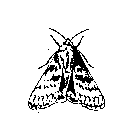
Yellowish dome shape, laid singly on corn silks, leaves, etc.; hatches in 2-10 days.
Light green or brown to almost black caterpillar, usually striped; head yellow, legs dark; rolls up when disturbed; pupates in soil after feeding for 3-4 weeks.

Pupa: 5-15 cm deep in soil; emerges in 10-25 days or more or overwinter (in South).
Usually 2 in northern range (e.g., eastern Canada), more in south.
Larva attacks CORN (especially: SWEET CORN), TOMATO, TOBACCO, COTTON, BEAN, PEPPER, LETTUCE EGGPLANT, PEA, POTATO, SQUASH and certain garden flowers.
CORN: Enters tip of ear via silks, devours kernels, fouls ear with moist excrement; also feeds in leaf whorls. Molds may develop at feeding sites and their toxins can Poison livestock.
TOMATO: Eats foliage, fruits (especially when green; usually enters from stem end).
1 Sold as Dipel® and Thuricide®
Ver(s)-gris
Noctuidae (many species)
* indicates damaging stage
Moth with dark gray forewings, variously marked.
Laid singly or in clusters, on stems and leaf sheaths of grasses, weeds and crops.
Plump, soft-bodied, dull in colour, some with coarse or bristly skin; feeds at night; during day lies at base of plant, just below soil surface; curls up when disturbed; may overwinter in soil, under trash, etc. (most single-generation species).
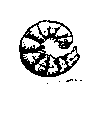
In soil; emerges in 1-8 weeks or after winter ( multigeneration species).
1-4, 1-2 in eastern Canada. Most single-generation species overwinter as larvae.
Larvae attacks CABBAGE family** (mainly), CORN, TOMATO, BEAN, PEPPER, SQUASH, etc.
Cuts through plant stems near soil level; climbing cutworms eat leaves.
**Includes BROCCOLI, BRUSSELS SPROUT, CABBAGE, CAULIFLOWER, KALE, KOHLRABI, MUSTARD, RADISH, RUTABAGA, TURNIP, etc. and related WEEDS.
1 Sold as Dipel ~ and Thuricide @.
2 Sold as Puronuard ~ and Fossil Flower @
livrée d'Amérique
Malcosoma americanus
* indicates damaging stage
Yellowish brown to dark chocolate brown moth (female often lighter), with two oblique whitish stripes on each wing.
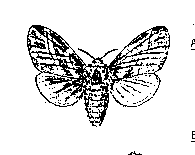
In shiny, dark brown, saddlelike cases 2cm long (150-350 eggs), straddling or encircling twigs of susceptible trees; laid in fall
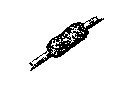
Black caterpillar with whitish back-stripe and blue, yellow and reddish-brown markings; sparsely hairy; makes commune webs, usually in tree forks; matures in 4-6 weeks.

In tough, yellow to white cocoon on tree trunks, fences, debris and on ground; moth emerges after two weeks.

One. Overwinter as eggs
Caterpillar attacks leaves of WILD CHERRY, WILD PLUM, APPLE and other orchard and shade trees; weakens (but seldom kills) trees.
Populations fluctuate greatly, usually in 7-10 year cycles, in phase with natural controls
1 The related FOREST TENT CATERPILLAR does not make webs
2 Sold as Dipel® and Thuricide®
Pyrale du maïs
Ostrinia nubilalis
* indicates damaging stage
Buff-coloured moth with dark wavy bands across wings (males smaller, darker); emerges from May to August; nocturnal.
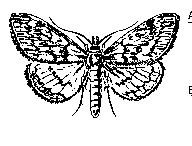
White to yellowish; flat clusters of 5-50 overlapping eggs laid on underside of lower leaves; hatch in 7 days.
Flesh-coloured caterpillar with inconspicuous brown spots, black head; hibernates in plant tissue (e.g., cornstalks near ground-level) pupates there in spring.
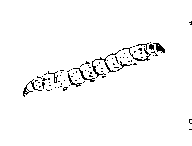
In spring forms loose cocoon in cavity where larva hibernated.
1-2 in eastern Canada.
Attacks CORN, EGGPLANT, PEPPER BEET, BEAN, POTATO, TOMATO, OAT, SOYBEAN, various flowers (e.g., CHRYSANTHEMUM, DAHLIA, GLADIOLUS) and certain weeds.
Look for holes in stem, with fine "sawdust" nearby, broken stalks and tassels, also attacks ears and leaves. Many larvae may infest one plant
1 Sold as Dipel® ~ and Thuricide®.
Sphinx de la tomate
Manduca quinquemaculata
* indicates damaging stage
"Hawk" moth; greyish brown; sips nectar; emerges from pupa in late spring.
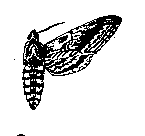
Round, greenish; laid singly on undersides of leaves
Green with oblique white bars; "horn" on rear end; may resemble curled up leaf (locate by dark green droppings on ground below); feeds ravenously for 3-4 weeks, then pupates.

10-12 cm deep in soil; dark brown hard, spindle-shaped; overwinters as pupa.
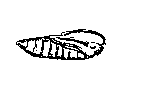
1-4: 1 in northern range
Attacks TOMATO, TOBACCO, POTATO, PEPPER, EGGPLANT an related weeds.
Eats leaves (mostly) and fruit.
1 Sold as Dipel® ~ and Thuricide®
Pégomie de l'épinard
Pegomya hyoscyami
* indicates damaging stage
Slender fly; grey with black hairs, two wings; starts to emerge in April or May.
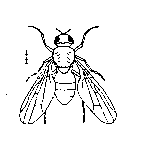
White, oval, sculptured; 2-20 laid in clusters on underside of leaf; hatch in 3-5 days; female lays up to 300 over a month or more.
Pale green to whitish maggot with pointed head (other groups with leaf miners have a dark head capsule); eats tissue between surfaces of leaf; may migrate from leaf to leaf. When fully grown (1-3 weeks), falls to ground to pupate.

Usually in upper 5-6 cm of soil sometimes in trash on ground; rarely in larval mine. Adult emerges after 2-4 weeks, or (if last generation) after winter.
Generations/Year
2-4
Attacks SPINACH, BEET, SUGAR BEET, CHARD, LETTUCE, CARROT, PARSNIP, CELERY and many weeds, e.g., CHICKWEED, LAMB'S QUARTERS, NIGHTSHADE.
Feeds between not through, leaf surfaces.
Mine is at first narrow, winding; then (as maggot grows) widens to form pale blotch filled with dark excrement; may join mines of other larvae. Can stunt plant.
Favoured by cool, moist weather; first generation does most damage.
Limace
Limacidae (Mollusca)
* indicates damaging stage
Slimy, soft-bodied, legless; resembles shell-less snail; may live more than a year; hides in damp, sheltered places during day.
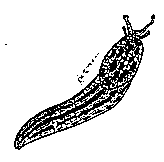
Laid in masses in damp places Often held together with sticky, substance, hatch in one month.
Attacks CABBAGE family**, LETTUCE, POTATO, flowers, small fruit. etc.
Eats leaves at night, leaving a slimy trail (shiny when dried); feeds on roots in winter ;
** Includes BROCCOLI, BRUSSELS SPROUT, CABBAGE, CAULIFLOWER, KALE, KOHLRABI, MUSTARD, RADISH, RUTABAGA, TURNIP, etc. and related weeds.
1 Sold as Puroguard®, Fossil Flower® and also "INSECTIGONE".
Copyright © 1990 Ecological Agriculture Projects
Info Request | Services | Become EAP Member | Site Map
Give us your comments about the EAP site
Ecological Agriculture Projects, McGill University (Macdonald
Campus)
Ste-Anne-de-Bellevue, QC, H9X 3V9 Canada
Telephone:
(514)-398-7771
Fax:
(514)-398-7621
Email: eapinfo@macdonald.mcgill.ca
To report problems or otherwise comment on the structure of this site, send mail to the Webmaster